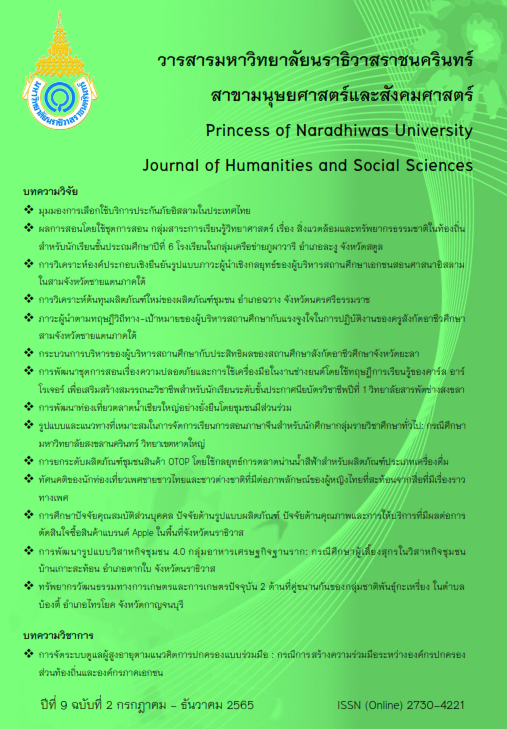Leadership based on Path-Goal Theory of School Administrators and Job Motivation of Teachers under Vocational Education in the Three Southern Border Provinces
Main Article Content
Abstract
The purpose of this research was to study and compare the relationship between leadership based on Path-Goal theory of school administrators and job motivation of teachers under vocational education in the three southern border provinces. The samples of this research were 260 people. The research instrument was a five-level rating scale questionnaire with an IOC of .60 or higher and a reliability of .98. The data were analyzed using statistics; frequency, percentage, mean, standard deviation, t-test, F-test, pair-wise comparison test by Scheffe method and Pearson’s Correlation. The research results showed that school administrators had leadership based on Path-Goal theory in all aspects at a high level. The overall work motivation of teachers was at a high level. The hypothesis test results indicated that differences in gender, age and education background had no difference in leadership based on Path-Goal theory. However, teachers receiving different types of experience had difference in work motivation with a statistical significance at .05. In addition, it was found that the overall relationship between leadership based on Path-Goal theory of school administrators and job motivation of teachers showed positive correlation at a high level with a statistical significance at .01.
Article Details

This work is licensed under a Creative Commons Attribution-NonCommercial-NoDerivatives 4.0 International License.
References
จิรวัฒน์ วรุณโรจน์. (2559). ความสัมพันธ์ระหว่างภาวะผู้นำการเปลี่ยนแปลงของผู้บริหารกับความพึงพอใจ ในการปฏิบัติงานของบุคลากรในสถาบันอุดมศึกษาเอกชนเขตภาคตะวันออกเฉียงเหนือ.วารสารศึกษาศาสตร์ ฉบับวิจัยบัณฑิตศึกษา มหาวิทยาลัยขอนแก่น,10(4), 26-33.
ดาราวดี บรรจงช่วย. (2560). ภาวะผู้นำของผู้บริหารสถานศึกษาตามการรับรู้ของครู สังกัดสำนักงานเขตพื้นที่การศึกษามัธยมศึกษา เขต 11 ในจังหวัดชุมพร. (การคนควาอิสระครุศาสตรมหาบัณฑิต). มหาวิทยาลัยราชภัฏสุราษฎร์ธานี, สุราษฎร์ธานี.
ธานินทร์ ศิลป์จารุ. (2563). การวิจัยและวิเคราะห์ข้อมูลทางสถิติด้วย SPSS (พิมพ์ครั้งที่ 11). กรุงเทพฯ : วี.อินเตอร์ พริ้นท์,
นฤมล จิตรเอื้อ, เฉลิมชัย กิตติศักดิ์นาวิน, และนลินณัฐ ดีสวัสดิ์. (2560). บทบาทภาวะผู้นำในการพัฒนาองค์การสู่องค์การแห่งการเรียนรู้. วารสารสาขามนุษยศาสตร์ สังคมศาสตร์ และศิลปะ. มหาวิทยาลัยศิลปากร, 10(2), 1738–1754.
นพวรรณ ประกายสกุล. (2556). การศึกษาความสัมพันธ์ระหว่างภาวะผู้นำของผู้บริหารสถานศึกษากับความพึงพอใจในการปฏิบัติงานของครู สังกัดสำนักงานเขตพื้นที่การศึกษาประถมศึกษานครสวรรค์ เขต 2. (วิทยานิพนธ์ครุศาสตรมหาบัณฑิต). มหาวิทยาลัยราชภัฏนครสวรรค์, นครสวรรค์.
บรรณสรณ์ นรดี. (2563). ความสัมพันธ์ระหว่างภาวะผู้นำเชิงพฤติกรรมของผู้บริหารสถานศึกษาและแรงจูงใจในการปฏิบัติงานของครูในกลุ่มพัฒนาคุณภาพการศึกษาโคกเพชร ดองกำเม็ด สำนักงานเขตพื้นที่การศึกษาประถมศึกษาศรีสะเกษ เขต 3. วารสารนวัตกรรมการศึกษาและการวิจัย มหาวิทยาลัยราชธานี, 4(3), 305-317.
ปราณี เข็มทอง. (2557). การศึกษาความสัมพันธ์ระหว่างภาวะผู้นำของผู้บริหารสถานศึกษากับความพึงพอใจในการปฏิบัติงานของครูผู้สอน สังกัดสำนักงานเขตพื้นที่การศึกษามัธยมศึกษา เขต 7. (วิทยานิพนธ์ครุศาสตรมหาบัณฑิต). มหาวิทยาลัยราชภัฏรำไพพรรณี, จันทบุรี.
พนมภรณ์ ศรีโคตร. (2562). ความสัมพันธ์ระหว่างแบบภาวะผู้นำของผู้บริหารสถานศึกษากับความพึงพอใจการปฏิบัติงานของครู สังกัดสำนักงานเขตพื้นที่การศึกษาประถมศึกษาพระนครศรีอยุธยา เขต 1. (วิทยานิพนธ์ครุศาสตรมหาบัณฑิต). มหาวิทยาลัยราชภัฏนครราชสีมา, นครราชสีมา.
ภูมิภัทร สุวรรณศรี. (2560). ภาวะผู้นำเชิงวิถีทางเป้าหมายของผู้บริหารสถานศึกษากับแรงจูงใจในการปฏิบัติงานของครูในโรงเรียนคาทอลิก สังกัดสังฆมณฑลจันทบุรี. (วิทยานิพนธ์ครุศาสตรมหาบัณฑิต). มหาวิทยาลัยราชภัฏรำไพพรรณี, จันทบุรี.
วราภรณ์ ช้างอยู่. (2557). ความสัมพันธ์ระหว่างภาวะผู้นำของผู้บริหารสถานศึกษากับความพึงพอใจในการปฏิบัติงานของครูผู้สอน สังกัดสำนักงานเขตพื้นที่การศึกษาประถมศึกษา กรุงเทพมหานคร. (วิทยานิพนธ์ศึกษาศาสตรมหาบัณฑิต). มหาวิทยาลัยเทคโนโลยีราชมงคลธัญบุรี, ปทุมธานี.
สุมาวดี พวงจันทร์, เอกรินทร์ สังข์ทอง, ผ่องศรี วาณิชย์ศุภวงศ์, และเรชา ชูสุวรรณ. (2559). การพัฒนาการจัดการอาชีวศึกษาจังหวัดชายแดนภาคใต้. วารสารวิทยบริการ. มหาวิทยาลัยสงขลานครินทร์ วิทยาเขตปัตตานี, 26(2), 122-130.
Karen, M. Bare-Oldham. (1999). An Examination of the Perceived Leadership Styles of Kentucky Public School Principals as Determinants of Teacher Job Satisfaction in Selected Catholic Elementary School (Ed.D. Dissertation). West Verginia University, U.S.A.
House, R. J., & Mitchell, T. R. (1974). Path-goal theory of leadership. Journal of Contemporary Business, 25, 81-87.
Herzberg, F., Mausner, B. & Snyderman, B.B. (2010). The Motivation to Work (12th ed.). New Brunswick, NJ: Transaction Publishers.
Wetherell, K.M. (2003). Principal leadership stlye and teacher job satisfaction. (Ed.D. thesis). Section Hall University, New Jersey.


